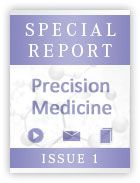Early Detection of Resistance in Lung Cancer Detected Through ctDNA in Urine
An assay that measures circulating tumor (ct) DNA in the urine can detect the early acquisition of epidermal growth factor receptor (EGFR) resistance mutations in patients with metastatic lung adenocarcinoma.
Hatim Husain, MD

Hatim Husain, MD
An assay that measures circulating tumor (ct) DNA in the urine can detect the early acquisition ofepidermal growth factor receptor(EGFR) resistance mutations in patients with metastatic lung adenocarcinoma. Data presented at the 2015 ASCO Annual Meeting demonstrate that monitoring urinary ctDNA for these mutations can predate radiographic progression and track response to anti-EGFR therapy.
“In some patients we were able to detect anEGFR T790Mresistance mutation in urinary ctDNA months before progression on anti-EGFR tyrosine kinase inhibitors (TKIs),” said Hatim Husain, MD, assistant professor of medicine, Division of Hematology-Oncology, Moores Cancer Center at the University of California, San Diego. Use of ctDNA in urine or blood may complement tissue biopsy to identify patients who may be developing resistance and may inform early therapeutic decision making. “Further larger studies are ongoing to demonstrate the importance of ctDNA approaches complementing tissue-based molecular testing,” Husain said.
Discussion of liquid biopsies has generally revolved around identification of driver mutations using ctDNA from the blood. The study presented here described the performance of a urine-based testing system that extracts ctDNA from large-volume urine samples and uses polymerase chain reaction to amplify small DNA fragments while enriching for mutant alleles with oligonucleotide-blocking technology. The authors looked at time-matched samples between tissueT790Mand urine to assess concordance. In 14 patients who were tissue positive byT790M, all were urine positive. Further studies are under way to characterize sensitivity and specificity in larger cohorts, according to Husain.
Acquisition of theEGFR T790Mresistance mutation is a mechanism of resistance among patients with metastaticEGFR-mutant lung adenocarcinoma treated with first-generation anti-EGFR TKIs. Most patients with metastatic lung adenocarcinoma treated with first-line anti-EGFR TKIs develop acquired resistance to these targeted therapies by 8 to 12 months. The secondaryT790Mmutation occurs in approximately 60% of patients with acquired resistance to EGFR TKIs.
Of 35 patients with metastatic lung adenocarcinoma receiving erlotinib in whom the urine assay was performed,EGFR T790Mmutation was detected in 24 (69%) at any timepoint.
An average of 0.4 µg of ctDNA could be detected in urine samples.T790Mcould be identified with a lower limit of detection of two copies in a background of 60-ng wild-type DNA.
In three patients who had tissue that was negative forT790M,but who had high clinical suspicion noted by slow indolent progression and typical time course, urinaryT790Mwas identified and one patient had a repeat rebiopsy that confirmed positivity.
The authors sought to understand if theEGFRT790M mutation copies could be identified before radiographic progression in 24 patients treated with erlotinib monitored for acquisition ofT790Mmutation through the use of urinary ctDNA collected every 3 to 6 weeks. “In some patientsEGFR T790Mcould be detected in the urine 1 to 3 months before CT scan radiographic progression,” Husain said. "Future studies are being considered to characterize the therapeutic implications of earlier intervention with second-line therapy in patients who have early acquisition detected through various ctDNA assays."
The authors noted that urine collected daily during the first week of therapy demonstrated dynamic changes in ctDNA mutational load characterized by spikes, which may represent early markers of tumor lysis. Ongoing studies are looking at timed ctDNA analysis on therapy to monitor response compared with radiography.
Husain H, Vibat CRT, Woodward B, et al. Kinetic monitoring of EGFR Exon 19 del, L858R, and T790M in urinary circulating tumor DNA predicts radiographic progression and response in patients with metastatic lung adenocarcinoma.J Clin Oncol. 2015;33(suppl): Abstract 8081.
<<<


















